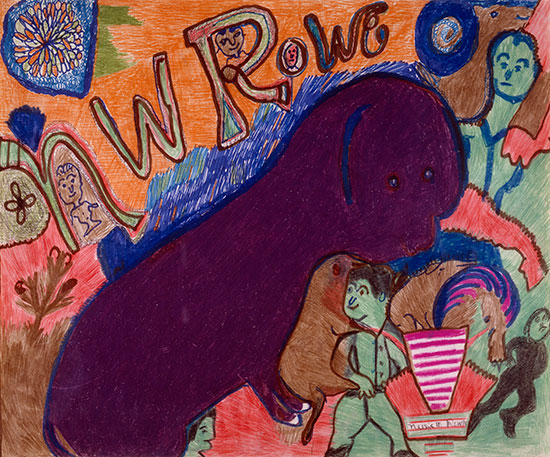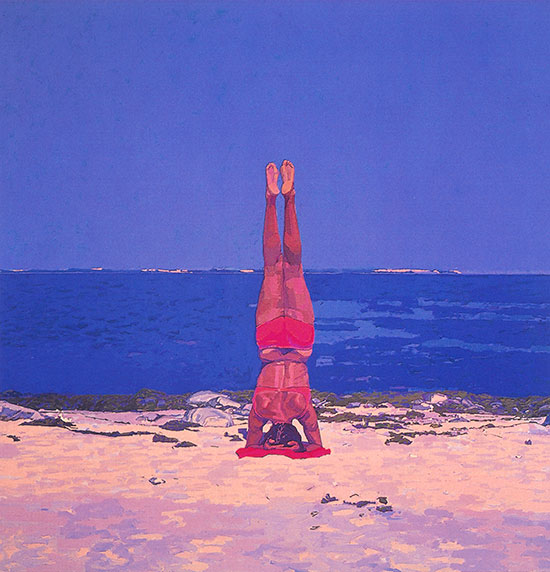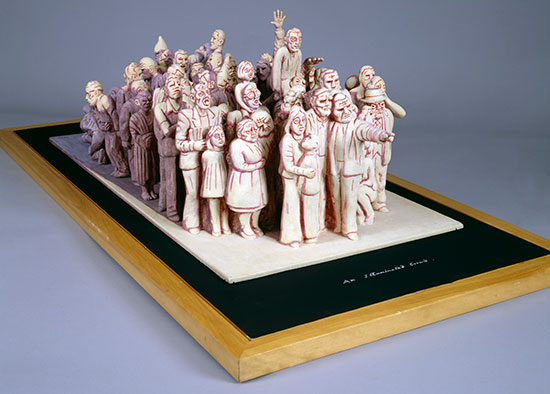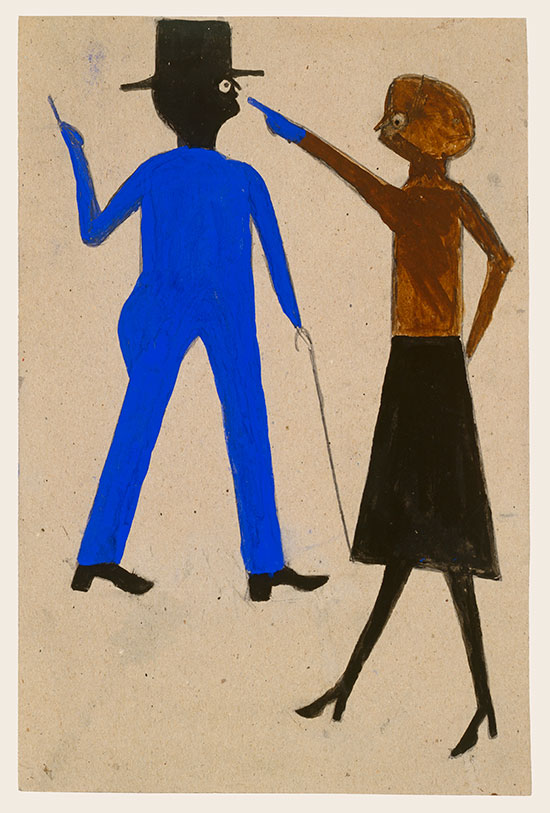MOUNT KISCO, N.Y. — It stands in the corner of a parking lot by an unassuming one-story building in Mount Kisco, N.Y. in Westchester County, not far from the MetroNorth train tracks. With its angled white segments soaring upward like the fluttering wings of a bird, the 20-foot-tall sculpture is a clue that the façade of the former electronics warehouse belies what is housed within.
Inside, the sprawling space is divided into roughly a dozen galleries that are filled with art. Paintings and drawings hang in clusters on every wall and rest in rows along specially designed shelving; hundreds more are mounted on vertical stacks of floor-to-ceiling sliding panels. Sculptures are everywhere: on pedestals, on the walls, on the floor, alongside books on bookcases, atop a couple of filing cabinets and, yes, in the parking lot.
.

"Emancipate I" by Paige Pedri, 2009. Fiberglass, 20 x 5 x 5 feet. Louis-Dreyfus Family Collection, courtesy of The William Louis-Dreyfus Foundation Inc.
.
This is the William Louis-Dreyfus Foundation, a 16,000-square foot museum-quality viewing and storage facility for more than 3,000 works by more than 225 artists, all collected by William Louis-Dreyfus. The former chief executive of the commodities firm Louis Dreyfus Group, Louis-Dreyfus was a lawyer, a published poet, a philanthropist and the father of four, including Julia Louis-Dreyfus, currently playing the feisty Selina Meyer on HBO’s “Veep.” He was also an art aficionado who purchased his first piece, a Wassily Kandinsky watercolor, in 1965 and didn’t stop acquiring art until his death in September 2016 at age 84.
Visitors can see much of that art on regularly scheduled tours, during which they can explore both the breadth of the collection and the threads that characterized Louis-Dreyfus’s quirky vision. The collection has been described as “contrarian” and “against the grain,” said Christina Kee, the Foundation’s Assistant Curator. “William took pleasure in that,” she said. “He didn’t collect as an investment, and frankly, he was skeptical of what he called ‘that silly art world.’ He was interested in discovering new artists, in supporting artists who he believed were working with integrity and who would be working regardless of circumstance.”
.

"Purple Dog" by Nellie Mae Rowe, c. 1980. Crayon and felt tip on paper, 14 x 17 inches. The William Louis-Dreyfus Foundation Inc.
.
The collection includes compositions by the early 20th-century European masters Jean Dubuffet, Joan Miró and Alberto Giacometti, and pieces by well-known names like Helen Frankenthaler, Red Grooms, Rackstraw Downes, Claes Oldenburg and David Hockney. Monumental paintings by the British artist Graham Nickson are scattered throughout the galleries: bodies on beaches, dressing or undressing, lying on towels, their flesh drenched in the light of impossibly vibrant skies.
.

"Upside-Down Bather" by Graham Nickson, 1979-1982. Lascaux Acrylic on canvas, 125 x 126 inches. Louis-Dreyfus Family Collection, courtesy of The William Louis-Dreyfus Foundation Inc.
.
One of Louis-Dreyfus’s favorite artists was Raymond Mason, who was educated in England but spent much of his life in France. Louis-Dreyfus acquired more than 300 of Mason’s works; an entire gallery is devoted to his drawings, watercolors and reliefs.
Entering the lobby, guests encounter Mason’s sculpture “An Illuminated Crowd,” a ghostly group of huddled figures, some angry, others afraid. A woman clutches a child; another dangles a cigarette from her mouth. At the front, a man extends his arm and directs his finger with menace—or is it perplexity?—at the viewer. A larger, bronze version of the piece, made eight years later, is outside by the parking lot.
.

"An Illuminated Crowd" by Raymond Mason, 1979-1980. Epoxy resin and pant, 14 1/2 x 41 x 20 inches. Louis-Dreyfus Family Collection, courtesy of The William Louis-Dreyfus Foundation Inc.
.
Concentrations of individual artists are prevalent in the collection. “He collected in depth when he loved an artist,” Kee said. “It was not uncommon for him to purchase an entire show of an artist he believed in, and to support and collect from artists throughout their careers.”
While some of those artists, like Mason, were classically trained, a significant number were self-taught, so-called outsider artists, among them James Castle, Clementine Hunter, Thornton Dial and Bill Traylor, whom Kee called “one of America’s best known self-taught artists.”
.

"Woman Pointing at Man With Cane" by Bill Traylor, 1939 - 1942. Poster paint and pencil on cardboard, 17 1/8 x 11 1/8 inches. The William Louis-Dreyfus Foundation Inc.
.
Born into slavery in Alabama, Traylor was illiterate and worked on a farm for most of his life until, at age 84, he began to draw. He set up under a tin roof in front of a pool hall and over the next three years, produced an estimated 1,200 to 1,500 images, some of which are now in the collections of the Metropolitan Museum of Art and the Museum of Modern Art.
At the Foundation, two walls are covered with Traylor’s drawings and paintings, many done on cardboard, some with patches of unflinching color. There are simple pictures of animals: a black sow with a loopy tail, a yellow horse, a bright red dog. There are people: a one-legged man, a man in a polka-dotted shirt leaning on an umbrella, a woman pointing vehemently at a man holding a cane.
“They are more complex than they look,” Kee said of Traylor’s pieces. “They hint at a larger narrative.”
The Foundation is committed to raising awareness of the artists Louis-Dreyfus collected. To that end, the Foundation is now welcoming the public and has initiated educational programming for all ages, encouraging school groups to book private tours. “We’re different from a museum,” Kee said. “They can take their time here.”
Although the Foundation does not host exhibitions, it has a robust loan program and has contributed to shows at institutions such as the Morgan Library & Museum in Manhattan and the New Britain Museum of American Art in Connecticut. The Foundation provided all of the works for “Leonardo Cremonini 1925-2010: Timeless Monumentality—Paintings from The William Louis-Dreyfus Foundation,” currently at the Fairfield University Art Museum through March 4, 2017.
The impetus for the Foundation, a 501(c)(3) private operating organization established in 2013, was a long-held philanthropic desire that found its outlet when Louis-Dreyfus met Geoffrey Canada, President of the Harlem Children’s Zone. Since the 1990s, the Harlem Children’s Zone has served more than 12,300 Harlem-based youths, supporting them from toddlerhood through college graduation with the aim of breaking the cycle of generational poverty. Louis-Dreyfus was so impressed with the organization’s mission and achievements that when he formed the Foundation, its directors designated the Harlem Children’s Zone as a primary beneficiary of sales of selected artwork from his collection.
Through the alliance, Louis-Dreyfus wedded three of his passions: art, education and justice. The power of that convergence is the subject of the documentary “Generosity of Eye.” The film, released in 2015, features Julia Louis-Dreyfus in conversation with artists, curators and dealers, as well as Canada and her father. She described the blending of her father’s convictions as “a sweet miracle for him.”
Unlike a curated museum exhibition, a collection is a reflection of the evolution of an individual personal vision. At the William Louis-Dreyfus Foundation, most but not all of the works are from the 20th and 21st centuries, and most but not all are representational. Nevertheless, their content, styles, materials and approaches vary wildly, testament to Louis-Dreyfus’s eclectic aesthetic.
Yet the works share a common trait. Each bears witness to the efforts of its creator, the presence of the artist’s hand. In “Generosity of Eye,” Louis-Dreyfus cited the work of one of the artists, Stanley Lewis, as emblematic of the collection—and of what he himself responded to in the work he acquired. Standing beside a painting by Lewis, Louis-Dreyfus called it “very worked. As you can see, this was not just put together in a day or two.”
“I react to it,” he said. “I like to see the act of painting in the painting.”
.

"View From Studio Window" by Stanley Lewis, 2003-2004. Graphite on paper, 44 5/8 x 50 1/2 inches. Louis-Dreyfus Family Collection, courtesy of The William Louis-Dreyfus Foundation Inc.
.
__________________________________
BASIC FACTS: The William Louis-Dreyfus Foundation is located in Westchester County in Mount Kisco, NY 10549. Tours are scheduled on Mondays, Tuesdays and Wednesdays at 11 a.m. and 2 p.m.; admission is free. For information or to request a tour, email [email protected] or visit www.wldfoundation.org. The collection can also be viewed online by clicking here.
__________________________________
Copyright 2017 Hamptons Art Hub LLC. All rights reserved.
